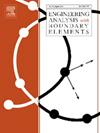求解奇摄动反应扩散问题的区域分解周动力微分算子
IF 4.1
2区 工程技术
Q1 ENGINEERING, MULTIDISCIPLINARY
Engineering Analysis with Boundary Elements
Pub Date : 2025-10-11
DOI:10.1016/j.enganabound.2025.106500
引用次数: 0
摘要
构造了奇异摄动反应扩散问题的域分解周动力微分算子(DD-PDDO)方法。该方法首先使用背景网格(如此处的Shishkin网格)将计算域划分为不重叠的子域;然后利用PDDO对各子域的问题进行独立求解;最后利用一阶导数在界面处的连续性作为约束机制,将各子域的解组合在一起。该方法克服了原PDDO方法在确定栅格比较大的界面过渡点处相互作用域大小时采用权函数的缺点。数值算例验证了在大网格比条件下,DD-PDDO方法比PDDO方法具有更强的稳定性和更高的精度。本文章由计算机程序翻译,如有差异,请以英文原文为准。
Domain decomposition peridynamic differential operator for solving singularly perturbed reaction–diffusion problems
A domain decomposition peridynamic differential operator (DD-PDDO) method for singularly perturbed reaction–diffusion problems is constructed. The method first uses the background mesh, such as Shishkin mesh here, to divide the computational domain into nonoverlapping subdomains; then uses PDDO to solve the problem in each subdomain independently; finally uses the continuity of the first-order derivative at the interface as a constraint mechanism to combine the solution of subdomains together. Present method overcomes the disadvantages of the weight function in the original PDDO for determining the interaction domain size at the interface transition points which have a large grid ratio. Numerical examples verify that the DD-PDDO method has stronger stability and higher accuracy than the PDDO method under conditions of large grid ratio.
求助全文
通过发布文献求助,成功后即可免费获取论文全文。
去求助
来源期刊

Engineering Analysis with Boundary Elements
工程技术-工程:综合
CiteScore
5.50
自引率
18.20%
发文量
368
审稿时长
56 days
期刊介绍:
This journal is specifically dedicated to the dissemination of the latest developments of new engineering analysis techniques using boundary elements and other mesh reduction methods.
Boundary element (BEM) and mesh reduction methods (MRM) are very active areas of research with the techniques being applied to solve increasingly complex problems. The journal stresses the importance of these applications as well as their computational aspects, reliability and robustness.
The main criteria for publication will be the originality of the work being reported, its potential usefulness and applications of the methods to new fields.
In addition to regular issues, the journal publishes a series of special issues dealing with specific areas of current research.
The journal has, for many years, provided a channel of communication between academics and industrial researchers working in mesh reduction methods
Fields Covered:
• Boundary Element Methods (BEM)
• Mesh Reduction Methods (MRM)
• Meshless Methods
• Integral Equations
• Applications of BEM/MRM in Engineering
• Numerical Methods related to BEM/MRM
• Computational Techniques
• Combination of Different Methods
• Advanced Formulations.
 求助内容:
求助内容: 应助结果提醒方式:
应助结果提醒方式:


